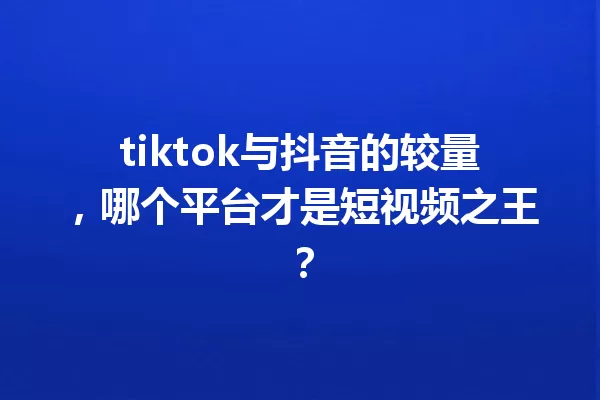
In recent years, short video platforms have taken the social media landscape by storm, and none have been more influential than TikTok and its Chinese counterpart, Douyin. While both platforms offer similar content creation tools and user experiences, they cater to distinct audiences and follow unique cultural trends. Understanding these differences is crucial for creators and brands looking to optimize their engagement strategies.
User Demographics and Cultural Context
One of the primary differences between TikTok and Douyin lies in their user demographics. TikTok, which gained immense popularity outside of China, appeals to a diverse age range, predominantly focusing on users aged 16-
Furthermore, the cultural context in which these platforms operate significantly influences content trends. TikTok users often engage with global trends, utilizing trending challenges, music, and memes that resonate across borders. Conversely, Douyin’s content is deeply rooted in local culture, showcasing traditional Chinese practices, festivals, and localized humor. For brands, understanding these nuances is vital when crafting targeted marketing campaigns.
Key Features and Functionalities
Both platforms boast an impressive set of features that enhance user engagement, but there are subtle yet significant differences. TikTok is known for its robust editing tools, including a vast library of sounds, effects, and filters. These features encourage creativity and the potential for virality, enabling users to produce high-quality content with relative ease.
Douyin, however, includes unique functionalities tailored to its Chinese audience. For instance, it integrates e-commerce features directly into the platform, allowing users to purchase products featured in videos seamlessly. This “see now, buy now” mentality is deeply ingrained in Chinese consumer habits and positions Douyin as a powerful tool for brands looking to drive sales through influencer partnerships.
Comparison of Key Features
| Feature | TikTok | Douyin |
|---|---|---|
| User Demographic | 16-24 years | 5-45 years |
| Content Style | Globally influenced | Localized cultural content |
| E-commerce Integration | Limited | Integrated features |
| Editing Tools | Robust and creative | Custom for Chinese audience |
Monetization Opportunities
Both TikTok and Douyin offer monetization opportunities for creators, though the approaches differ remarkably. TikTok employs a creator fund model where users earn money based on views and engagement, allowing individuals to carve out a niche and monetize their creativity. This model has led to a flourishing community of creators who can sustain themselves financially through their content.
Douyin takes monetization a step further by allowing users to directly sell products through their videos. Influencer marketing is a cornerstone of Douyin’s ecosystem, with brands collaborating with popular creators to promote their products. The effectiveness of these partnerships is evidenced by the high conversion rates seen in Douyin’s e-commerce features. This integration of entertainment and shopping has made Douyin particularly appealing to businesses looking to leverage influencer reach.
In essence, while TikTok and Douyin are built on similar principles of short-form video creation, they differ significantly in user demographics, cultural influences, platform features, and monetization strategies. Users and brands must navigate these differences to effectively engage their target audiences on each platform.
When it comes to the nuances between TikTok and Douyin, the distinctions become quite apparent. TikTok is designed with a global audience in mind, particularly appealing to those in the 16-24 age bracket. Its content often reflects worldwide trends that resonate across different cultures. In contrast, Douyin provides a more extensive demographic reach, accommodating users aged 5-45 years. This broader age range allows Douyin to embrace a variety of content styles, heavily influenced by local customs and traditions unique to China. While TikTok revels in its international appeal, Douyin immerses its users in culturally rich narratives that are both familiar and relevant to a Chinese audience.
The monetization pathways available on both platforms also reveal interesting dynamics. TikTok encourages creativity through its creator fund, which compensates video-makers based on their engagement and viewership. It’s a system that nurtures talent but can be unpredictable. On the flip side, Douyin capitalizes on e-commerce by integrating direct sales within its videos, transforming influencers into instant sales channels. This feature not only enhances the shopping experience but also solidifies influencer marketing as a critical revenue generator. While TikTok is slowly exploring shopping features, Douyin’s sophisticated e-commerce integration establishes it as a frontrunner in turning creativity into cash, ensuring that creators can seamlessly blend entertainment with commerce.
Frequently Asked Questions (FAQ)
What are the main differences between TikTok and Douyin?
TikTok primarily targets a global audience, especially users aged 16-24, while Douyin caters to a broader age range of 5-45 years. Additionally, TikTok features globally influenced trends, whereas Douyin focuses on localized cultural content and practices unique to China.
Can creators monetize their content on both platforms?
Yes, creators can monetize their content on both TikTok and Douyin. TikTok utilizes a creator fund model that compensates users based on views and engagement. Douyin, on the other hand, allows direct product sales within videos, making influencer marketing a significant revenue stream.
How do TikTok and Douyin handle e-commerce?
TikTok has limited e-commerce integration compared to Douyin. While TikTok is gradually introducing shopping features, Douyin has a well-developed system that enables seamless shopping through video content, making it easier for users to make purchases directly from influencers.
Are the editing tools different for TikTok and Douyin?
Yes, while both platforms offer robust editing tools, TikTok tends to focus on a wider variety of global styles and effects. Douyin, however, tailors its editing features to better suit the preferences and cultural nuances of its Chinese audience.
Which platform is better for reaching a younger audience?
TikTok is generally better for reaching a younger audience, especially those within the 16-24 age range. However, Douyin also caters to younger users and has a significant presence among children and teens aged 5-12 years, along with older demographics up to 45 years.
内容结尾插入,支持HTML代码,如果不需要请删除